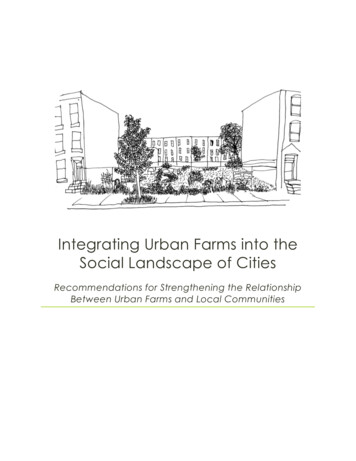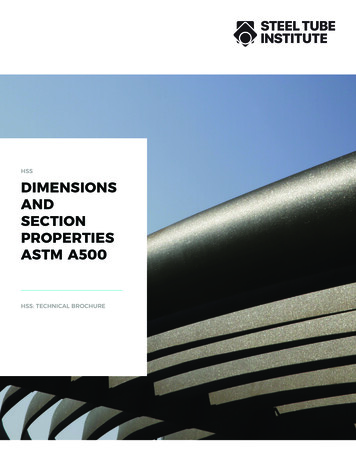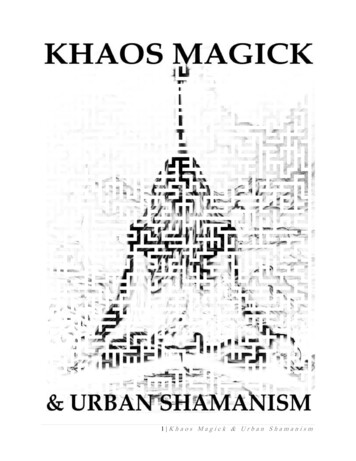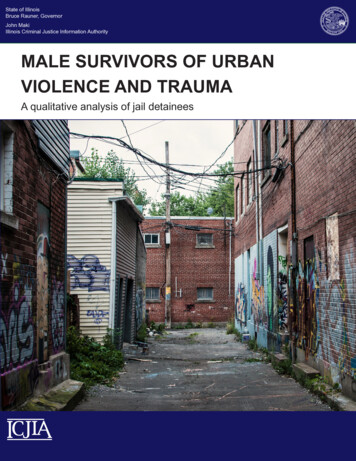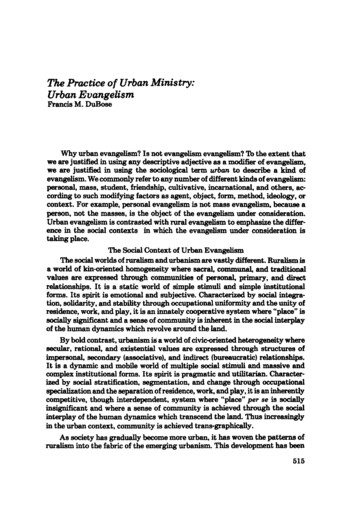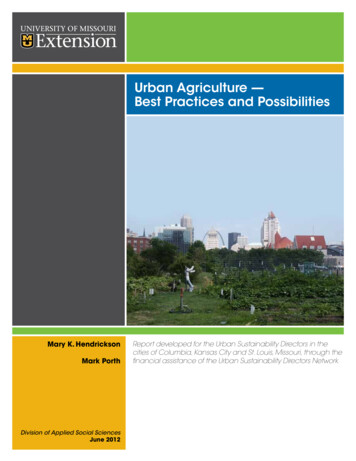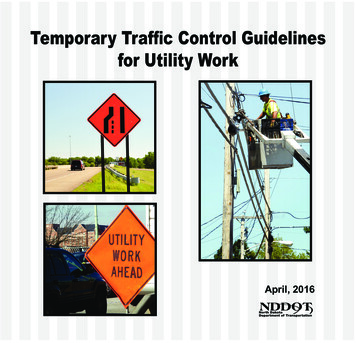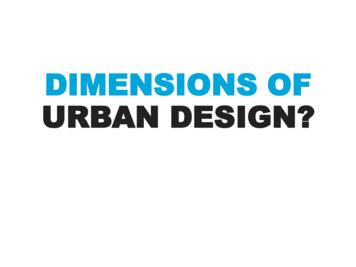
Transcription
DIMENSIONS OFURBAN DESIGN?
THE MORPHOLOGICALDIMENSION The 'morphological' dimension of urban design; is the layout andconfiguration of urban form and space. There are essentially two types of urban space system 'traditional' and'modernist‘. 'Traditional' urban space consists of buildings as constituent parts ofurban blocks, where the blocks define and enclose external space. 'Modernist' urban space typically consists of freestanding 'pavilion'buildings in landscape settings. During the modern period, the morphological structure of the publicspace network has changed in two important ways: From buildings as constituent elements in urban blocks (i.e. connectedterraced masses) defining 'streets' and 'squares', to buildings asseparate freestanding pavilions standing in an amorphous 'space'; And From integrated and connected small scale finely meshed street grids,to road networks surrounding segregated and introverted 'enclaves'. In each case there is currently a reaction to these changes.
THE MORPHOLOGICALDIMENSION
THE MORPHOLOGICALDIMENSION
THE PERCEPTUALDIMENSION Awareness and appreciation of environmental perception, and, inparticular, of perception and experience of 'place', is an essentialdimension of urban design. Since the early 1960s an interdisciplinary field of environmentalperception has developed, and there now exists a significant bodyof research on people's perception of their urban environment. An initial concern with environmental images has beensupplemented by work on symbolism and meaning in the builtenvironment. The interest in environmental perception has also been reinforcedby a body of work focusing on the experiential 'sense of place'and 'lived-in' experiences associated with urban environments. Environmental perception leads to the construction of place, interms of sense of place.
THE PERCEPTUALDIMENSIONCertain paths are significant in supporting clearmental maps of cities or parts of cities. The mentalmaps of Londoners locate various other parts ofLondon – such as The Mall, Piccadilly Circus, andOxford Street – in relation to Regent Street
THE SOCIAL DIMENSION Social dimension of urban design concerns how Space and Society are related: It is difficult to conceive of 'space' without social content and, equally, toconceive of society without a spatial component. The relationship is best conceived as a continuous two-way process in whichpeople (and societies) create and modify spaces while at the same time beinginfluenced by them in various ways. Social relations can be: constituted through space (e.g. where sitecharacteristics influence settlement form); constrained by space (e.g. wherethe physical environment facilitates or obstructs human activity); andmediated by space (e.g. where the 'friction of distance' facilitates or inhibitsthe development of various social practices). Hence, by shaping that built environment, urban designers influence patternsof human activity and social life. There is five key aspects of urban design's social dimension: The first is the relationship between people and space.The second is the interrelated concepts of the 'public realm' and 'public life'.The third concerns the notion of neighborhoods.The fourth concerns issues of safety and security.The fifth is the issue of accessibility.
THE VISUAL DIMENSION Visual - or, more precisely, the visual-aesthetic - dimension of urbandesign Architecture and urban design are often described as the only trulyinescapable, and therefore public, art forms. While observers can choose whether or not to experience art,literature and music, urban design does not afford such a choice: In their daily activities, people must pass through and experience thepublic parts of the city environment. Thus, while we may 'accept the idea of "high" visual arts that appeal toa narrow audience who choose to visit a museum, city form andappearance must satisfy the broader public who regularly experiencesit. There are four key issues to the visual dimension: The first part concerns aesthetic preferences. The second concerns the appreciation of space and the aesthetic qualities ofurban spaces and townscape. The third and fourth concern the design of elements that define and occupyurban space – the architecture, and the hard and soft landscaping.
THE VISUAL DIMENSION
THE VISUAL DIMENSIONPrinciples of containment andEnclosure
THE VISUAL DIMENSIONWidth-to-Iength ratios help distinguishbetween 'street‘ spaces and 'square' spaces.If the ratio of width-to-lengthis 2:3 neither axis dominates.Ratios of about 1:3 begin to form the transitionbetween 'street' and 'square', as one axisbegins to dominate.Where the ratio of width-to-Iength is 1 :5, oneaxis clearly dominates and movement issuggested along that axis.Width-to-Iength proportions of more than 1:5suggest a street
THE VISUAL DIMENSION
THE FUNCTIONALDIMENSION Functional dimension of urban design involves how placeswork and how urban designers can make 'better' places. The 'social usage' and 'visual' traditions of urban designthought each had a 'functionalist' perspective. That of the former concerned the functioning of theenvironment in terms of how people used it, while in thelatter, the human dimension was often abstracted out andreduced to aesthetic or technical criteria such as traffic flow,access or circulation. These two sets of functional considerations, can be furtherdeveloped in four parts: The first part concerns the use of public spaces.The second concerns mixed uses and density considerations.The third environmental designThe fourth aspects of the capital web.
THE FUNCTIONAL DIMENSIONMAGNETSRetail developers and designers are skilled in exploiting shopper psychology and manipulating shoppermovements within shopping centers. In the simplest form of centers, the 'magnet' stores are located ateither end of a central mall lined with smaller stores. The magnet stores attract shoppers to the mall. Asshoppers enter the mall, they are drawn towards the magnet stores and in the process pass the smallerstores, thereby, generating footfall and potential trade for those smaller stores. If shoppers enter throughone of the magnet stores, the other magnet stores provide the stimulus for movement along the mall.This is admittedly a simplified account of movement. The magnet stores attract people in the aggregate;they may not attract any particular individual. Equally, it may be the ambience and character of themall's 'public' spaces that are the real attraction.
THE FUNCTIONAL DIMENSIONSPATIAL STRUCTURE (THE CAPITAL WEB)
THETEMPORALDIMENSION Although sometimes considered to be a matter of working in three dimensions, urbandesign is four-dimensional: The fourth dimension being time. As time passes, spaces become lived-in places, made more meaningful by their timethickened qualities. We experience the passage of time in the urban environment in two ways: Through 'rhythmic repetition': 'the heartbeat, breathing, sleeping and waking, hunger, the cycles of sun andmoon, the seasons, waves, tides, clocks‘ Through 'progressive and irreversible change': growth and decay, not recurrence but alteration'. Time and space are intimately related. Space and time 'are the great framework within which we order our experience. We live intime-places.‘ A city 'is more than a place in space, it is a drama in time' (from Cowan, 1995, p. 1). There are three key aspects of the temporal dimension of urban design: First, as activities are fluid in space and time, environments are used differently at different times. Urbandesigners need to understand time cycles and the time management of activities in space. Second, although environments relentlessly change over time, a high value is often placed on some degree ofcontinuity and stability. Urban designers need to understand how environments change, what stays the sameand what changes over time. They also need to be able to design and manage environments that canaccommodate the inevitability of time's passage. Third, urban environments change over time, and urban design projects, policies, etc., are implemented overtime.
THE TEMPORAL DIMENSION
THE TEMPORAL DIMENSION
THE MORPHOLOGICAL DIMENSION The 'morphological' dimension of urban design; is the layout and configuration of urban form and space. There are essentially two types of urban space system 'traditional' and


